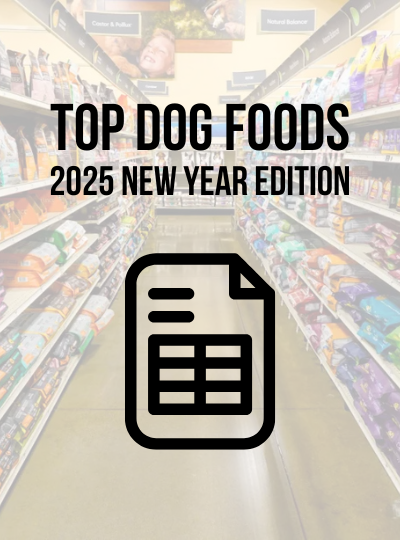Switching Dog Food After an Allergy Trial: What You Need to Know
I recently had a client call me with a question about switching food after a dog food allergy trial.
He told me that he had switched to a novel protein, Kangaroo, and was feeding Zignature LID dog food. He had been diligent in feeding his dog, Scotty, only this food as part of an elimination diet, which he called a “food allergy trial.”
He asked, “Now that we have finished the food allergy trial, I’m looking at dog food ingredients and they all have chicken. Do all dog foods have chicken? What do I switch to after the food allergy trial? My vet said we can reintroduce foods after 12 weeks.”
Understanding Dog Food Labels
I explained to him why dog food that says “with Beef” or “Beef flavor” might still have chicken in the ingredients. Chicken is a cheaper ingredient, and dog food that says “with …” only has to have 3% of that ingredient. If it says “beef flavor,” it means it has to have a detectable amount of the named flavor but doesn’t have to contain any real beef. Dog food has to be named according to what’s in the ingredients ordered by weight. But if it says “with Beef” or “beef flavor,” then it doesn’t have to be the majority of the food. Only less than 3%. That’s why it’s important to look at the full ingredient list if your dog has food sensitivities to something like chicken.
Why Switch from Zignature?
Next, I asked why he wanted to switch from Zignature if the food was working for Scotty. He said that the food was expensive. This is usually a surprise when switching to limited ingredient dog food. It is much more expensive than the more popular grocery store brands that he was used to buying (e.g., Purina, Pedigree, Iams, and others).
What to Feed After an Elimination Diet
So, what do you feed your dog after an elimination diet or food allergy trial?
Here are my recommendations:
- Stick with the same food that you used on the elimination diet if it’s working for your dog.
- Continue to avoid any foods that you know cause problems, e.g., chicken.
- Read labels carefully and stick with treats and other foods that have simple whole food ingredients instead of ones with lots of synthetic ingredients and flavoring.
- Introduce treats with different proteins or foods that you want to try, one at a time. For example, pork treats if your dog can’t have chicken. If you don’t see a reaction, then you can include those in the diet. If not, stop and try a different protein.
- Easiest treats to try are single ingredient treats like beef liver or duck hearts.
Personal Experience with Food Sensitivities
I have a lot of experience with food sensitivities. I’ve had three dogs with food sensitivities and I’ve done a lot of experimenting.
I told my client about my dog Jackson. He can’t have chicken either. He’s been on a diet without chicken for years. I change proteins, but never chicken. So, you would think based on what some people say, that I could reintroduce the chicken and he might be okay with it by now.
Nope! Every now and then I will have a dog staying with me and Jackson, and I will give that dog their treats that have chicken. I think, well, Jackson wants to have one, what harm will one treat with chicken have? So I give it to him.
Sure enough, within a few days, his ears will be inflamed and he’ll start scratching his ears. No more chicken, no more ear problems.
(Note: Ear problems are Jackson’s first signs of his food intolerances. Other dogs show different symptoms.)
TL;DR
What I Recommend to Feed After an Elimination Diet:
- Stick with the same food that you used on the elimination diet if it’s working for your dog.
- Continue to avoid any foods that you know cause problems, e.g., chicken.
- Read labels carefully and stick with treats and other foods that have simple whole food ingredients instead of ones with lots of synthetic ingredients and flavoring.
- Introduce treats with different proteins or foods that you want to try, one at a time. For example, pork treats if your dog can’t have chicken. If you don’t see a reaction, then you can include those in the diet. If not, stop and try a different protein.
- Easiest treats to try are single ingredient treats like beef liver or duck hearts.
Here are my Top Dog Food Brands with Limited Ingredients (LID) or Single Protein Source:

Cyndi Smasal, CPDT-KA
Certified Professional Dog Trainer / Integrative Pet Specialist
Author, Pet Nutrition Specialist and Pet Care/Health Coach
Why I’m a “Dog Food Geek”
Twenty years ago my first dog, Norman, was diagnosed with liver disease and given a month to live. I wasn’t ready to give up on him so I did a lot of research (not on Google as it wasn’t what it is today back in 2002). The full story is in my book “Hope for Healing Liver Disease in Your Dog”. What I learned in my research was just how bad the commercial dog food was that I had fed him his whole life. I learned that his commercial food likely contributed to his bad health (at 10 years old). Or if it didn’t cause his poor health, it definitely didn’t help. I can’t tell you how awful the guilt is of realizing that what you’ve been feeding your dog their whole life has led to their current state of bad health. I have spent the last 20 years learning about canine nutrition so that I would never feel that way again.
The good news is that I saved Norman’s life and he went on to live for 2 more years. And the point of this story is that his diet was the major contributing factor in his recovery from cirrhosis. I fed him a fresh home-cooked diet for 2 years. It saved his life and made me a believer in “fresher is better”.



